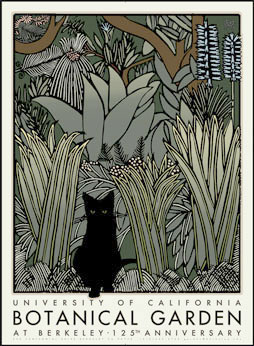
Click on image for detail
(239) U C Botanical Garden 125th Anniversary:
Edition of 1808 of which 225 copies are signed 1-225, 27 copies are signed A-Zz as artist's proofs. Three sets of progressives.
March 1, 2016
17-1/2" x 24" - Fourteen Colors - Paper: Mohawk Superfine 100 lb. Cover
Influence: Henri Julien Felix Rousseau (1844 - 1910) French; "The Snake Charmer" , 1907
Model: Fiona
Client: U C Botanical Garden
1-125: Saint Hieronymus Press
126-225: U C Botanical Garden
A-Zz: Artist's own use
Progressives: One set to the UC Botanical Garden, two sets to Saint Hieronymus Press
Dedication copies: Sarah Elizabeth Francis, UC Botanical Garden, Katherine and Chuck Greenberg, Paul and Barbara Licht, Janet and Norm Pease, Claire Nicole Stremple, Phil & Barbara Stremple
Posters may be order on the web at http://botanicalgarden.berkeley.edu/the-garden-shop/
Alternatively, they may be ordered by emailing gardenshop@berkeley.edu
Masacchio, born Tommaso di Ser Giovanni di Simone in 1401, was, according to Vasari, the best painter of his generation. In "The Expulsion from the Garden of Eden," (c. 1425) Adam and Eve are depicted leaving the doorway of the Garden, naked and wracked with grief, threatened by a sword-bearing, vengeful angel. The strangely menacing, hallucinogenic Eden of Hieronymus Bosch (c. 1450 - 1516) is less comforting than the zoological extravaganza depicted by Lucas Cranach the Elder (1472 - 1553). Michelangelo's (1475 - 1564) muscular Adam and Eve are cast out by another red-clad angel, but the central character is that of the sinuous, enticing, half-female serpent. Thomas Cole's (1801 - 1848) Eden dwarfs the tiny, insignificant human figures with an overwhelming abundance of exotic greenery. Henri Rousseau (1844 - 1910) depicts Eden-like gardens, but leaves Adam and Eve out entirely, as though the expulsion were so complete that they never even existed.
It all reminds me of the gradual disappearance of "enemies of the state", such as Leon Trotsky and Nikolai Yezhov, from Russian photographs under Stalin. Adam and Eve are first cast out, then gradually disappear from depictions of the Garden of Eden until, like the Cheshire Cat, nothing remains of them but a faint, ghostly grin.